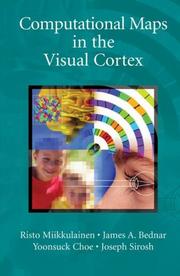| Listing 1 - 4 of 4 |
Sort by
|

ISBN: 0387288066 0387220240 1441919589 Year: 2005 Publisher: New York, NY : Springer New York : Imprint: Springer,
Abstract | Keywords | Export | Availability | Bookmark
 Loading...
Loading...Choose an application
- Reference Manager
- EndNote
- RefWorks (Direct export to RefWorks)
Biological structures can be seen as collections of special devices coordinated by a matrix of organization. Devices are dif?cult to evolve and are meticulously conserved through the eons. Organization is a ?uid medium capable of rapid adaptation. The brain carries organizational ?uidity to the extreme. In its context, typical devices are ion channels, transmitters and receptors, signaling pathways, whole individual neurons or speci?c circuit patterns. The border line between what is to be called device and what a feat of organization is ?owing, given that in time organized s- systems solidify into devices. In spite of the neurosciences’ traditional concentration on devices, their aiming point on the horizon must be to understand the principles by which the nervous system ties vast arrays of internal and external variables into one coherent purposeful functional whole — to understand the brain’s mechanism of organization. For that purpose a crucial methodology is in silico experimentation. Computer simulation is a convenient tool for testing functional ideas, a sharp weapon for d- tinguishing those that work from those that don’t. To be sure, many alternatives can only be decided by direct experiment on the substrate, not by modeling. However, if a functional idea can be debunked as ?awed once tried in silico it would be a waste to make it the subject of a decade of experimentation or discussion. The venture of understanding the function and organization of the visual system illustrates this danger.
Visual cortex --- Computer simulation. --- Area striata --- Striate area --- Striate cortex --- Occipital lobes --- Neurobiology. --- Neurosciences. --- Ophthalmology. --- Biology --- Computer Appl. in Life Sciences. --- Data processing. --- Medicine --- Eye --- Neural sciences --- Neurological sciences --- Neuroscience --- Medical sciences --- Nervous system --- Neurosciences --- Diseases --- Bioinformatics . --- Computational biology . --- Bioinformatics --- Bio-informatics --- Biological informatics --- Information science --- Computational biology --- Systems biology --- Data processing

ISBN: 9780387220246 9780387288062 Year: 2005 Publisher: New York NY Springer New York
Abstract | Keywords | Export | Availability | Bookmark
 Loading...
Loading...Choose an application
- Reference Manager
- EndNote
- RefWorks (Direct export to RefWorks)
Biological structures can be seen as collections of special devices coordinated by a matrix of organization. Devices are dif?cult to evolve and are meticulously conserved through the eons. Organization is a ?uid medium capable of rapid adaptation. The brain carries organizational ?uidity to the extreme. In its context, typical devices are ion channels, transmitters and receptors, signaling pathways, whole individual neurons or speci?c circuit patterns. The border line between what is to be called device and what a feat of organization is ?owing, given that in time organized s- systems solidify into devices. In spite of the neurosciences' traditional concentration on devices, their aiming point on the horizon must be to understand the principles by which the nervous system ties vast arrays of internal and external variables into one coherent purposeful functional whole to understand the brain's mechanism of organization. For that purpose a crucial methodology is in silico experimentation. Computer simulation is a convenient tool for testing functional ideas, a sharp weapon for d- tinguishing those that work from those that don't. To be sure, many alternatives can only be decided by direct experiment on the substrate, not by modeling. However, if a functional idea can be debunked as ?awed once tried in silico it would be a waste to make it the subject of a decade of experimentation or discussion. The venture of understanding the function and organization of the visual system illustrates this danger.
Multi
ISBN: 9780387288062 Year: 2005 Publisher: New York, NY Springer Science+Business Media, Inc.
Abstract | Keywords | Export | Availability | Bookmark
 Loading...
Loading...Choose an application
- Reference Manager
- EndNote
- RefWorks (Direct export to RefWorks)
Biology --- Physiology of nerves and sense organs --- Neuropathology --- Ophthalmology --- Computer. Automation --- neurologie --- biologie --- informatica --- oftalmologie --- neurobiologie
Book

Year: 2015 Publisher: Frontiers Media SA
Abstract | Keywords | Export | Availability | Bookmark
 Loading...
Loading...Choose an application
- Reference Manager
- EndNote
- RefWorks (Direct export to RefWorks)
Python is rapidly becoming the de facto standard language for systems integration. Python has a large user and developer-base external to theneuroscience community, and a vast module library that facilitates rapid and maintainable development of complex and intricate systems. In this Research Topic, we highlight recent efforts to develop Python modules for the domain of neuroscience software and neuroinformatics: - simulators and simulator interfaces - data collection and analysis - sharing, re-use, storage and databasing of models and data - stimulus generation - parameter search and optimization - visualization - VLSI hardware interfacing. Moreover, we seek to provide a representative overview of existing mature Python modules for neuroscience and neuroinformatics, to demonstrate a critical mass and show that Python is an appropriate choice of interpreter interface for future neuroscience software development.
Software Development --- scientific computing --- collaboration --- python language --- interoperability
| Listing 1 - 4 of 4 |
Sort by
|

 Search
Search Feedback
Feedback About UniCat
About UniCat  Help
Help News
News